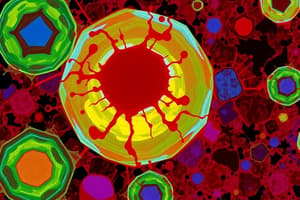Podcast
Questions and Answers
What is a characteristic of hypertrophy as a cellular adaptation?
What is a characteristic of hypertrophy as a cellular adaptation?
- Decreased functional demand
- Increase in cell size (correct)
- Change in cell type
- Decrease in cell number
Which type of hyperplasia occurs specifically due to the influence of hormones?
Which type of hyperplasia occurs specifically due to the influence of hormones?
- Physiologic hyperplasia (correct)
- Compensatory hyperplasia
- Pathologic hyperplasia
- Atrophy
In which scenario would atrophy most likely occur?
In which scenario would atrophy most likely occur?
- Hormonal stimulation during pregnancy
- Decreased usage or disuse of a body part (correct)
- Increased number of cells in liver
- Increased workload on cardiac muscle
How does hyperplasia differ from hypertrophy?
How does hyperplasia differ from hypertrophy?
What type of cellular adaptation is commonly associated with cardiac enlargement due to hypertension?
What type of cellular adaptation is commonly associated with cardiac enlargement due to hypertension?
Which of the following statements about atrophy is correct?
Which of the following statements about atrophy is correct?
Which of the following is a common morphological adaptation to stress?
Which of the following is a common morphological adaptation to stress?
What characterizes metaplasia in cellular adaptations?
What characterizes metaplasia in cellular adaptations?
Which scenario best describes physiological atrophy?
Which scenario best describes physiological atrophy?
What leads to dysplasia from hyperplasia?
What leads to dysplasia from hyperplasia?
Which of the following statements is true regarding necrosis?
Which of the following statements is true regarding necrosis?
What is a key characteristic of apoptosis?
What is a key characteristic of apoptosis?
Which morphological change is associated with necrosis?
Which morphological change is associated with necrosis?
Under what condition does apoptosis typically occur?
Under what condition does apoptosis typically occur?
Which of the following best describes the process of necrosis?
Which of the following best describes the process of necrosis?
What distinguishes apoptosis from necrosis?
What distinguishes apoptosis from necrosis?
What occurs during the process of apoptosis?
What occurs during the process of apoptosis?
When might apoptosis occur as part of normal physiology?
When might apoptosis occur as part of normal physiology?
What occurs when cells encounter stresses beyond their adaptive capacity?
What occurs when cells encounter stresses beyond their adaptive capacity?
Which of the following is NOT a cause of cellular stress or injury?
Which of the following is NOT a cause of cellular stress or injury?
What type of adaptation involves an increase in cell size without an increase in cell number?
What type of adaptation involves an increase in cell size without an increase in cell number?
Which of the following correctly describes pathological adaptations?
Which of the following correctly describes pathological adaptations?
Which statement about cell injury is true?
Which statement about cell injury is true?
What defines hyperplasia in cellular adaptations?
What defines hyperplasia in cellular adaptations?
In the context of cellular response to injury, what is aging categorized as?
In the context of cellular response to injury, what is aging categorized as?
Which of the following best describes metaplasia as a cellular adaptation?
Which of the following best describes metaplasia as a cellular adaptation?
What is the primary reason for metaplasia in epithelial cells?
What is the primary reason for metaplasia in epithelial cells?
What type of cell change occurs in cigarette smokers’ respiratory epithelium?
What type of cell change occurs in cigarette smokers’ respiratory epithelium?
Which statement describes reversible cell injury?
Which statement describes reversible cell injury?
What is a typical morphological change in reversible cell injury?
What is a typical morphological change in reversible cell injury?
As cell injury progresses to an irreversible state, which change occurs?
As cell injury progresses to an irreversible state, which change occurs?
What key indicator suggests the transition from reversible to irreversible cell injury?
What key indicator suggests the transition from reversible to irreversible cell injury?
What are large flattened cells and increased cytoplasmic granularity indicative of?
What are large flattened cells and increased cytoplasmic granularity indicative of?
Which of the following best describes the effects of a damaging agent on severely stressed cells?
Which of the following best describes the effects of a damaging agent on severely stressed cells?
Flashcards
Cellular Adaptation
Cellular Adaptation
A process where cells adjust to changes in their environment to maintain viability and function. It's a reversible change.
Hypertrophy
Hypertrophy
An increase in the size of cells, leading to an increase in the size of the organ. This occurs in cells that cannot divide.
Hyperplasia
Hyperplasia
An increase in the number of cells in an organ or tissue, leading to an increase in its size. This occurs in cells that can divide.
Atrophy
Atrophy
Signup and view all the flashcards
Metaplasia
Metaplasia
Signup and view all the flashcards
Cell Death
Cell Death
Signup and view all the flashcards
Hypoxia
Hypoxia
Signup and view all the flashcards
Chemical Agents
Chemical Agents
Signup and view all the flashcards
Pathological Hypertrophy
Pathological Hypertrophy
Signup and view all the flashcards
Dysplasia
Dysplasia
Signup and view all the flashcards
Genetic reprogramming
Genetic reprogramming
Signup and view all the flashcards
Cell Injury
Cell Injury
Signup and view all the flashcards
Reversible Cell Injury
Reversible Cell Injury
Signup and view all the flashcards
Morphological Changes in Reversible Cell Injury
Morphological Changes in Reversible Cell Injury
Signup and view all the flashcards
Irreversible Cell Injury
Irreversible Cell Injury
Signup and view all the flashcards
Senescence
Senescence
Signup and view all the flashcards
Necrosis
Necrosis
Signup and view all the flashcards
Apoptosis
Apoptosis
Signup and view all the flashcards
Nuclear shrinkage, fragmentation, and dissolution
Nuclear shrinkage, fragmentation, and dissolution
Signup and view all the flashcards
Breakdown of plasma and organelle membranes
Breakdown of plasma and organelle membranes
Signup and view all the flashcards
Cell shrinkage, chromatin condensation, and nuclear fragmentation
Cell shrinkage, chromatin condensation, and nuclear fragmentation
Signup and view all the flashcards
Apoptotic body formation
Apoptotic body formation
Signup and view all the flashcards
Phagocytosis by surrounding tissue
Phagocytosis by surrounding tissue
Signup and view all the flashcards
Study Notes
Cell Death
- Cell injury occurs when cells are overly stressed. They are no longer able to adapt or they have been exposed to a harmful agent.
- Cell injury can be reversible if the stimulus is removed.
- If the stress is severe or persists, it leads to irreversible injury and cell death.
- Cell death is essential for normal cell function and development.
Cellular Adaptations to Stress
- Adaptations are reversible changes to cells that respond to environmental demands and stimuli.
- Physiological adaptations occur in response to normal stimuli like hormones and chemical mediators.
- Pathological adaptations occur in response to stress; cells change structure and function to avoid injury.
- Common pathological adaptation types include:
- Hypertrophy: Increase in cell size.
- Hyperplasia: Increase in cell number.
- Atrophy: Decrease in cell size.
- Metaplasia: Change in cell type.
Hypertrophy
- Increased cell size resulting in increased organ size.
- It is not a result of new cells, but the existing cells enlarging.
- Occurs due to the increase in structural proteins and organelles.
- Occurs when nondividing cells are exposed to stress or an increased functional demand.
- Examples include the myocardium and skeletal muscle cells.
- Weightlifting can cause hypertrophy of skeletal muscles.
- Cardiac enlargement due to constant strain from hypertension can cause hypertrophy.
Hyperplasia
- Increase in the number of cells, which increases organ size.
- Only occurs in cells capable of replication.
- May occur with hypertrophy in response to similar stimuli.
- Physiological hyperplasia:
- Hormonal hyperplasia (e.g., breast development during puberty and pregnancy).
- Compensatory hyperplasia (e.g., liver regeneration after a portion is removed).
- Pathological hyperplasia: Excessive hormone or growth factor stimulation (e.g., HPV causing skin warts).
- If hyperplasia becomes irreversible, it can lead to dysplasia and potentially cancer.
Atrophy
- Decrease in the cell size.
- A loss of cell substance leads to decreased organ size.
- Caused by decreased workload (e.g., limb immobilization) or reduced blood supply (e.g., aging).
- Cells have a reduced function but are not dead.
- Often accompanied by autophagy (self-eating).
Metaplasia
- Reversible change where a cell type is replaced by another cell type.
- Cells sensitive to a particular stress can be replaced by other more resistant cell types.
- Likely stems from genetic reprogramming of stem cells.
- Commonly occurs in epithelial cells that are continuously replaced by stem cells.
- May result in reduced function or increased susceptibility to further damage.
- Example: Squamous change in the respiratory epithelium of cigarette smokers.
Mechanisms of Cell Injury
- Major sites of damage from stimuli include:
- ATP depletion
- Membrane damage
- Cytoskeletal damage
- DNA damage including the accumulation of misfolded proteins.
Overview of Cell Injury and Cell Death: Reversible Cell Injury
- Early or mild forms of injury lead to functional and morphological changes than can be reversed if the stimulus is removed.
- Examples include swelling or changes to the cytoplasm or organelles (e.g., kidney tubules).
- DNA damage can cause the cell cycle checkpoint to arrest the cell in cycle until the damage is repaired; otherwise apoptosis occurs.
Overview of Cell Injury and Cell Death: Cell Death
-
Continued damage causes cell death that is either necrosis or apoptosis; injury becomes irreversible.
-
Types of cell death include:
- Necrosis: Major pathway in many injuries, always a pathological process. The cell's integrity is lost.
- Apoptosis: Activated by a tightly controlled suicide program. The cell’s integrity is maintained; no inflammatory response typically occurs.
-
Changes in irreversible cell injury include:
- DNA damage
- Aging/senescence
- Permanent cell-cycle arrest (G1)
- Large flattened cells
- Increased vacuoles
- Cytoplasmic granularity
-
Morphological changes in irreversible injury (e.g. loss of nuclei, cell fragmentation, and leakage of contents).
Cell Death: Necrosis
- Degradative actions of enzymes cause cellular damage, leading to cell death.
- Morphological alterations include nuclear shrinkage, fragmentation, and dissolution
- Breakdown of plasma and organelle membranes.
- Necrosis involves a collection of cells in a tissue or organ, leading to tissue death or sometimes the entire organ's death (e.g., brain, kidney, or lung).
Cell Death: Apoptosis
- Apoptosis is activated by a controlled suicide program (triggered by physiological or pathological conditions).
- Cell activation of enzymes occurs in a regulated manner to degrade itself, without harming neighboring cells.
- The plasma membrane has integrity, so there is no cell content spill into the surrounding area, and a no inflammatory response occurs.
- Morphological alterations of apoptosis include cell shrinkage and chromatin condensation, membrane blebbing and nuclear fragmentation. Apoptotic bodies are formed, which can then be phagocytosed by surrounding tissues.
Mechanisms of apoptosis
- Two main pathways exist; intrinsic (mitochondrial pathway) and extrinsic (death receptor pathway).
- Each has its own initiators, regulators, and executioners to activate a programmed cell death process.
Studying That Suits You
Use AI to generate personalized quizzes and flashcards to suit your learning preferences.



